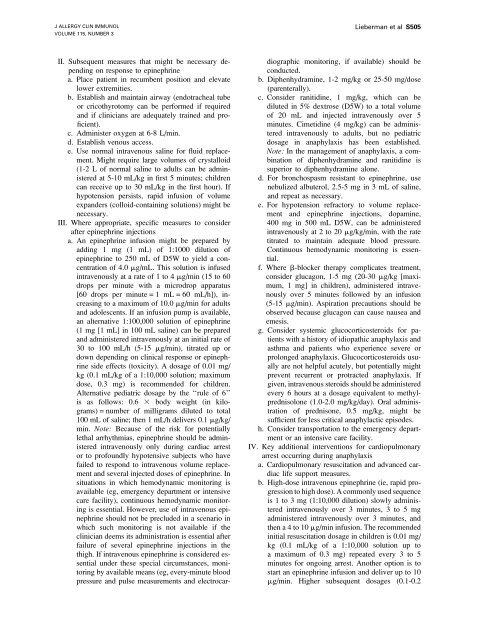Immunotherapy Safety for the Primary Care ... - U.S. Coast Guard
Immunotherapy Safety for the Primary Care ... - U.S. Coast Guard
Immunotherapy Safety for the Primary Care ... - U.S. Coast Guard
Create successful ePaper yourself
Turn your PDF publications into a flip-book with our unique Google optimized e-Paper software.
J ALLERGY CLIN IMMUNOL<br />
VOLUME 115, NUMBER 3<br />
Lieberman et al S505<br />
II. Subsequent measures that might be necessary depending<br />
on response to epinephrine<br />
a. Place patient in recumbent position and elevate<br />
lower extremities.<br />
b. Establish and maintain airway (endotracheal tube<br />
or cricothyrotomy can be per<strong>for</strong>med if required<br />
and if clinicians are adequately trained and proficient).<br />
c. Administer oxygen at 6-8 L/min.<br />
d. Establish venous access.<br />
e. Use normal intravenous saline <strong>for</strong> fluid replacement.<br />
Might require large volumes of crystalloid<br />
(1-2 L of normal saline to adults can be administered<br />
at 5-10 mL/kg in first 5 minutes; children<br />
can receive up to 30 mL/kg in <strong>the</strong> first hour). If<br />
hypotension persists, rapid infusion of volume<br />
expanders (colloid-containing solutions) might be<br />
necessary.<br />
III. Where appropriate, specific measures to consider<br />
after epinephrine injections<br />
a. An epinephrine infusion might be prepared by<br />
adding 1 mg (1 mL) of 1:1000 dilution of<br />
epinephrine to 250 mL of D5W to yield a concentration<br />
of 4.0 mg/mL. This solution is infused<br />
intravenously at a rate of 1 to 4 mg/min (15 to 60<br />
drops per minute with a microdrop apparatus<br />
[60 drops per minute = 1 mL = 60 mL/h]), increasing<br />
to a maximum of 10.0 mg/min <strong>for</strong> adults<br />
and adolescents. If an infusion pump is available,<br />
an alternative 1:100,000 solution of epinephrine<br />
(1 mg [1 mL] in 100 mL saline) can be prepared<br />
and administered intravenously at an initial rate of<br />
30 to 100 mL/h (5-15 mg/min), titrated up or<br />
down depending on clinical response or epinephrine<br />
side effects (toxicity). A dosage of 0.01 mg/<br />
kg (0.1 mL/kg of a 1:10,000 solution; maximum<br />
dose, 0.3 mg) is recommended <strong>for</strong> children.<br />
Alternative pediatric dosage by <strong>the</strong> ‘‘rule of 6’’<br />
is as follows: 0.6 3 body weight (in kilograms)<br />
= number of milligrams diluted to total<br />
100 mL of saline; <strong>the</strong>n 1 mL/h delivers 0.1 mg/kg/<br />
min. Note: Because of <strong>the</strong> risk <strong>for</strong> potentially<br />
lethal arrhythmias, epinephrine should be administered<br />
intravenously only during cardiac arrest<br />
or to profoundly hypotensive subjects who have<br />
failed to respond to intravenous volume replacement<br />
and several injected doses of epinephrine. In<br />
situations in which hemodynamic monitoring is<br />
available (eg, emergency department or intensive<br />
care facility), continuous hemodynamic monitoring<br />
is essential. However, use of intravenous epinephrine<br />
should not be precluded in a scenario in<br />
which such monitoring is not available if <strong>the</strong><br />
clinician deems its administration is essential after<br />
failure of several epinephrine injections in <strong>the</strong><br />
thigh. If intravenous epinephrine is considered essential<br />
under <strong>the</strong>se special circumstances, monitoring<br />
by available means (eg, every-minute blood<br />
pressure and pulse measurements and electrocardiographic<br />
monitoring, if available) should be<br />
conducted.<br />
b. Diphenhydramine, 1-2 mg/kg or 25-50 mg/dose<br />
(parenterally).<br />
c. Consider ranitidine, 1 mg/kg, which can be<br />
diluted in 5% dextrose (D5W) to a total volume<br />
of 20 mL and injected intravenously over 5<br />
minutes. Cimetidine (4 mg/kg) can be administered<br />
intravenously to adults, but no pediatric<br />
dosage in anaphylaxis has been established.<br />
Note: In <strong>the</strong> management of anaphylaxis, a combination<br />
of diphenhydramine and ranitidine is<br />
superior to diphenhydramine alone.<br />
d. For bronchospasm resistant to epinephrine, use<br />
nebulized albuterol, 2.5-5 mg in 3 mL of saline,<br />
and repeat as necessary.<br />
e. For hypotension refractory to volume replacement<br />
and epinephrine injections, dopamine,<br />
400 mg in 500 mL D5W, can be administered<br />
intravenously at 2 to 20 mg/kg/min, with <strong>the</strong> rate<br />
titrated to maintain adequate blood pressure.<br />
Continuous hemodynamic monitoring is essential.<br />
f. Where b-blocker <strong>the</strong>rapy complicates treatment,<br />
consider glucagon, 1-5 mg (20-30 mg/kg [maximum,<br />
1 mg] in children), administered intravenously<br />
over 5 minutes followed by an infusion<br />
(5-15 mg/min). Aspiration precautions should be<br />
observed because glucagon can cause nausea and<br />
emesis.<br />
g. Consider systemic glucocorticosteroids <strong>for</strong> patients<br />
with a history of idiopathic anaphylaxis and<br />
asthma and patients who experience severe or<br />
prolonged anaphylaxis. Glucocorticosteroids usually<br />
are not helpful acutely, but potentially might<br />
prevent recurrent or protracted anaphylaxis. If<br />
given, intravenous steroids should be administered<br />
every 6 hours at a dosage equivalent to methylprednisolone<br />
(1.0-2.0 mg/kg/day). Oral administration<br />
of prednisone, 0.5 mg/kg, might be<br />
sufficient <strong>for</strong> less critical anaphylactic episodes.<br />
h. Consider transportation to <strong>the</strong> emergency department<br />
or an intensive care facility.<br />
IV. Key additional interventions <strong>for</strong> cardiopulmonary<br />
arrest occurring during anaphylaxis<br />
a. Cardiopulmonary resuscitation and advanced cardiac<br />
life support measures.<br />
b. High-dose intravenous epinephrine (ie, rapid progression<br />
to high dose). A commonly used sequence<br />
is 1 to 3 mg (1:10,000 dilution) slowly administered<br />
intravenously over 3 minutes, 3 to 5 mg<br />
administered intravenously over 3 minutes, and<br />
<strong>the</strong>n a 4 to 10 mg/min infusion. The recommended<br />
initial resuscitation dosage in children is 0.01 mg/<br />
kg (0.1 mL/kg of a 1:10,000 solution up to<br />
a maximum of 0.3 mg) repeated every 3 to 5<br />
minutes <strong>for</strong> ongoing arrest. Ano<strong>the</strong>r option is to<br />
start an epinephrine infusion and deliver up to 10<br />
mg/min. Higher subsequent dosages (0.1-0.2
















